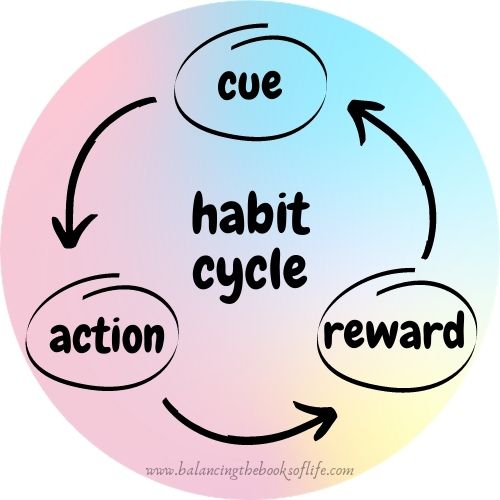“To change a habit, you must keep the old cue, and deliver the old reward, but insert a new routine.”
The Power of Habit by Charles Duhigg

Last week I talked about what habits are, how they react in your brain, how long they take to develop, why it’s hard to develop good habits, and 2 really key points to maximizing your success rate for habit formation. If you haven’t read it yet, head here now.
This week, I want to dive into the steps for how to practice good habits.
Steps to Successfully Develop Good Habits
Before I get started, I have to comment on my definition of good habits as I move forward. We are talking about how to develop good habits in this article, but only in the sense that it is a habit you want to have. As such, a “good” habit is only good if you perceive it to be good, which is to say it is a habit you want, and are content with having.
1. To develop good habits you must gain clarity.
The first step to the formation of good habits is to understand the habit and the why. I don’t care if you want to stop a bad habit (which you can’t actually do, you can only change it), change a habit, or create a new habit. Really reflect on what habit you are trying to modify and create, and why. Let’s say you are trying to build a habit of stretching every morning before you wake up. What are you really trying to accomplish? Are you trying to exercise more? Are you in pain in the mornings? Gain more flexibility? Connect with your body before you start your day? Why is the morning the best time to accomplish this action? Why is stretching the best action to carry out whatever it is you are really truly trying to accomplish?
You can also take this step towards modifying an existing habit. For example, right now I am a terrible cycle of staying up extremely late – well past my exhaustion level – and then sleeping in past my alarm in the morning and being awfully late. It’s not a great habit to have formed. If I reflect on why, it’s because I am relishing the time. That time is completely mine where no one is demanding anything from me. I don’t have to be an employee, a mom, or a wife; I can just be me. But it’s coming at the cost of my sleep. So now I have the means to start exploring other avenues in which I can satisfy my need to be removed from the responsibilities I have from others, while not sacrificing my sleep.

2. Identify triggers.
The trigger is the most important step to successful habit formation. It is the foundation in which your brain is triggered to complete an action. In a lab rat, it might be the release of the gate that allows him to run the maze. If you are on Facebook too much, it might literally be just looking at your phone screen that triggers your brain to look for the little blue f icon. If you are changing a habit, the key is to correctly identify the trigger that occurs.
Pay attention to your habit for a while before taking any action on it. Having a clear indication of the trigger is the only thing that is going to allow you to modify the action. If it is a new habit and you need a new trigger, choose wisely. A trigger can be an action, and it’s best if it’s one you already do. In our stretching example, a trigger we might choose is to do it after our morning coffee/tea, or right before we get into the shower.
For example, trying to start a habit of walking 10 minutes a day after breakfast, when you don’t normally eat breakfast, is going to be a lot harder than walking 10 minutes a day when you get the mail. If you already get the mail every day, and you’re already in your shoes and outside, it’s easier to just continue and get your walk in.
Related Reading:
Budgeting tools to help you track expenses.
5 habits to help keep your home clean
ways to increase productivity when working from home
3. Identify the reward.
The last part of the habit cycle is the reward, and it is an important one. The kick of dopamine is what keeps the habit going, and if the habit is something that feels unpleasurable, it will be very difficult to continue. Sometimes, a reward can be the hardest part. But a habit for a reward doesn’t necessarily have to be like a reward for hitting a big goal. It doesn’t have to be life shattering. It just has to be pleasurable for the brain.
In our stretching example, the shower may be the reward. Another example might be if you are trying to track your calories to pay closer attention to what you are eating, eating the particular food you tracked might be the reward. It has to be immediate. It cannot be, say, a piece of chocolate at the end of a day of staying within calories. The habit doesn’t recognize pleasurable actions that happen hours after the fact.
If you are trying to change a habit, the reward may not change that much. For example, if I have a tendency to have a late-night snack and this is something I want to try to stop doing, one way I could try to do this is to have a cup of herbal tea, no sugar added, when I feel tempted to have a snack. My brain is triggered; maybe coming down after putting the kids to bed triggers my brain to have a snack. I walk into the kitchen and instead of grabbing a snack, I make tea. I’ve changed the action. My reward is still something that is going into my mouth and stomach. I’ve fooled my brain into thinking I’ve had the sugary snack, instead of a healthy cup of herbal tea. But in the process, the reward itself has not changed.
4. Modify your environment and identify obstacles
Right before we can get into the shower might work out really well, if we can remember it. Let us not forget, this is a new foreign action that our brain is unfamiliar with. And likely, you won’t remember that you forgot to stretch until you are already in the shower. In this instance, modifying our environment in such a way that can help us remember is beneficial. For instance, maybe I will put a yoga mat at the bathroom door, so that when I see the yoga mat, I am reminded of my goals to stretch before my shower.
Trying to identify potential setbacks and obstacles early gives you the time to work out a solution that can help keep you on track.

5. Focus on the action
By now we’ve gotten to a point where we understand the habit and why it’s important, we know our triggers and our rewards, and we’ve modified our environment to set us up for success. The next step is to focus on the action. There are two main things to keep in mind when it comes to the action step. Keep it small, and remove the emotion.
Radical change doesn’t happen overnight. Radical change is the result of small steps over the course of a long time. It goes back to that old time saying “Rome wasn’t built in a day.” Your habits aren’t either. If you try to go from couch potato to working out 2 hours a day 7 days a week, you’ll burn yourself out, and likely injure yourself in the process. It is important to start small to give yourself the best chance of success. Walk for 10 minutes. Set a 5-minute timer to clean up after dinner, but before your glass of wine. For my sleeping, I am moving up my bedtime in 15-minute increments, over time.
It needs to be something that feels doable and not completely overwhelming. Basically, you want something in which you basically can’t fail at. You want to find an action so small, it almost feels harder to not do than to just do it!
6. Develop Good Habits by tracking your progress
One of the best ways to see our progress is to track it. I personally tend to track all my habits in my bullet journal. It is easy for me to see it there. Play with your personality on this one. If you are competitive by nature, have a competition to see how many days you can do it in a row. My favorite way of tracking habit progress is to set it up just like a calendar, and then I can make a big X on the days that I do the action I am aiming to do. It feels very satisfying for me to be able to draw the X. Put it somewhere you know you will see it every day, without fail, and without shame.
Another way I have tracked a habit before is to make a paper clip chain. Every day (or time) I do the habit, I add a paper clip to my chain. Then I can just watch it grow. Again, if you are competitive, you could take the whole chain down if you miss a day. But if you aren’t, and you know the idea of starting over will kill your momentum, then just keep the chain growing. Work with your strengths.
I will talk about this more in the next point, but I have to bring it up here. Remove judgement on yourself. If you did it, cross it off. It doesn’t matter if it almost didn’t happen, or if it wasn’t perfect, or just the way you imagined. If the action happened and was successful, mark it down. If you didn’t do it, just note that. Take it in as information, give yourself a moment of reflection to figure out why, acknowledge that it was a tough day, and resolve to give it another shot tomorrow. One or two missed days will not mess up habit formation that is done consistently over a long period of time.

Optional: journal about your experience
This last one is optional. Journaling on your journey to develop good habits can be incredibly insightful and rewarding. It can open up your world to learn so much about yourself, if you let it. But, journaling itself, is a habit.
A lot of people will tell you to journal about your experience, your success or mistakes, your feelings about the action and habit, and how automated doing the action felt. These are indeed fantastic things to keep note of; however, if you are not someone who already journals, it is going to be cumbersome to try to do this! It will add a level of complexity to your habit building. Not to mention create an extra level of responsibility, and potentially dread, that comes with having to do the action/habit. We want this process to be successful, not cumbersome. Therefore, my advice is to do the journaling portion if you already journal, but to skip it if you don’t. Adding one more level of complexity is not the goal.
The fact of the matter is, with hard work and consistency, it is possible to build good habits. It likely won’t happen in 21 days, but you CAN make it happen. A habit is a cycle of three steps that the brain completes on autopilot: a trigger, an action, and a reward. Modifying, manipulating, and defining these three steps are crucial to develop good habits. The key steps to successful habit formation are understanding what you want, identifying triggers and rewards, modify your environment and remove obstacles, focus on the action, track your progress, and if so inclined, journal about the experience.
If you want to read more about habits, I highly recommend two books: Atomic Habits by James Clear and The Power of Habit of Charles Duhigg.


Michele is the fun-loving, easy going, project managing, financial savvy author behind the Balancing the Books of Life blog. She invites other moms to come along her journey to both become financially independent and spend time on things they love!


Leave a Reply